
Lagos de Moreno is a city and municipality in the State of Jalisco, Mexico. Lagos is located in the region of Los Altos de Jalisco, within the macroregion of the Bajío, one of the most highly developed areas in Latin America. Lagos de Moreno is occasionally known as the "Athens of Jalisco", owing to the numerous writers and poets who were born there.
Adelantado was a title held by Spanish nobles in service of their respective kings during the Middle Ages. It was later used as a military title held by some Spanish conquistadores of the 15th, 16th and 17th centuries.

The municipality and town of Totatiche is located in the northern extreme of the state of Jalisco, Mexico between 21°48’30” and 22°06’00” latitude north and 103°20’00” and 103°34’00” longitude east at a height of 1,751 meters (5,745 ft) above sea level. The municipality is bordered on the north and southeast by the state of Zacatecas. On the northeast, it shares its border with the municipality of Colotlán and on the west it is bordered by the municipalities of Villa Guerrero and Chimaltitán.
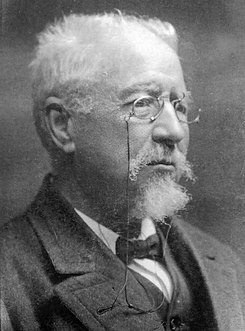
Manuel Antonio Martínez Murguía was a Galician journalist and historian who created the Real Academia Galega. He was one of the main figures in Galician Rexurdimento movement. He is also remembered as Rosalía de Castro's husband, publisher and main supporter.

The Chichimeca War (1550–90) was a military conflict between the Spanish Empire and the Chichimeca Confederation established in the territories today known as the Central Mexican Plateau, called by the Conquistadores La Gran Chichimeca. The epicenter of the hostilities was the region now called the Bajío. The Chichimeca War is recorded as the longest and most expensive military campaign confronting the Spanish Empire and indigenous people in Mesoamerica. The forty-year conflict was settled through several peace treaties driven by the Spaniards which led to the pacification and, ultimately, the streamlined integration of the native populations into the New Spain society.
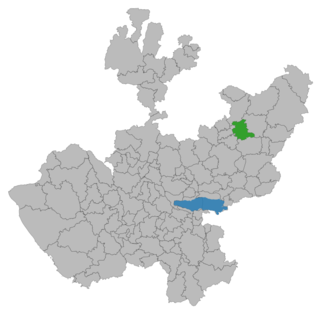
Jalostotitlán is a town and municipality located in the northeast corner of the state of Jalisco, Mexico, in a region known as Los Altos.

The Tecuexe were an indigenous peoples of Mexico, who lived in the eastern part of present-day Guadalajara.

San Juan de los Lagos is a city and municipality located in the northeast corner of the state of Jalisco, Mexico, in a region known as Los Altos. It is best known as the home of a small image of the Virgin Mary called Our Lady of San Juan de los Lagos or in Nahuatl Cihuapilli, which means “Great Lady.” Since the first major miracle ascribed to her in 1632, she has been venerated especially for cases involving mortal danger. The miracles ascribed to her have made the basilica in which she is found a major tourist attraction, which has shaped the city's history to this day. The economy of the city is still heavily dependent on the flow of pilgrims which has amounted to between seven and nine million people per year.

Encarnación de Díaz is a town and municipality located in the far northeast of the state of Jalisco in north-central Mexico. It is located in a natural pass that connects the Los Altos region of Jalisco to points north, and from pre-Hispanic times until the 20th century, it was a major thoroughfare for north-south travel. The town began as a way station along a road built through this pass in the 17th century, formally becoming a town in 1760. It began to function as a municipality in the latter 19th century, but this status was not confirmed until the early 20th. Transport, along with numerous prosperous haciendas supported the economy of the area until the early 20th century, when travel patterns and the Mexican Revolution spurred its decline. In the 1920s, it was a centre of rebellion during the Cristero War, and the town contains Mexico's only museum exclusively dedicated to this episode in history. It also contains a museum dedicated to various naturally occurring mummies which have been found in the municipal cemetery.
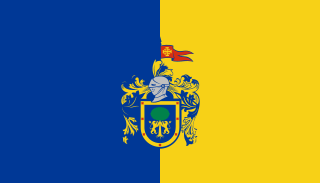
Jalisco, officially the Free and Sovereign State of Jalisco, is one of the 32 Federal Entities of Mexico. It is located in Western Mexico and is bordered by six states which are Nayarit, Zacatecas, Aguascalientes, Guanajuato, Michoacán, and Colima. Jalisco is divided into 125 municipalities, and its capital city is Guadalajara.
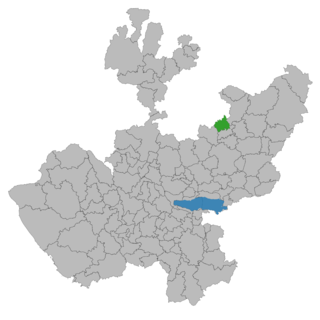
Mexticacán is a town and municipality in the Southern Zone of Los Altos Region of Jalisco. Mexticacán comes from the Nahuatl language and means "place where the temple for the worship of the moon".
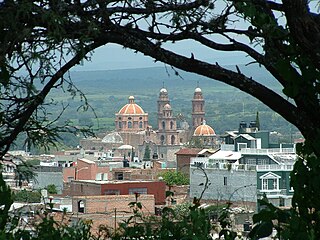
Teocaltiche is a town and municipality in the central-western Mexican state of Jalisco. It is located in the northeastern highlands region of Jalisco, commonly referred to in Spanish as "Los Altos de Jalisco". The grasshopper or "chapulin" is a popular icon for the town.

Ricardo Lancaster-Jones y Verea, MA BE KHS was a Mexican historian, diplomat, scholar, professor, art collector and sugarcane entrepreneur who made significant contributions toward the study of the haciendas of the State of Jalisco (Mexico) in the twentieth century. He spoke Spanish, English, French, Italian and Latin fluently. He authored and published numerous articles for newspapers and specialized magazines in Mexico, South America, Spain, United Kingdom and United States. His enthusiasm for history led him to become a professor of Regional History at the Faculty of Philosophy and Letters of Universidad Autónoma de Guadalajara in 1965. Later on, in 1973, he earned his MA degree in Latin American Studies at the University of New Mexico. He is especially mentioned by Mexican academics Mauricio Beuchot (2001) and José María Murià (2003) as an early historian of the haciendas in Western Mexico.

Los Altos de Jalisco, or the Jaliscan Highlands, are a geographic and cultural region in the eastern part of the Mexican state of Jalisco, famed as a bastion of Mexican culture, cradling traditions from Tequila production to Charrería equestrianism. Los Altos are part of the greater Bajío region of Mexico.

María Rita de la Trinidad Pérez Jiménez, commonly known as Doña Rita Pérez de Moreno, was an insurgent and heroine of the Mexican War of Independence, along with her husband Pedro Moreno.
Events in the year 1988 in Mexico.

Jalisco handcrafts and folk art are noted among Mexican handcraft traditions. The state is one of the main producers of handcrafts, which are noted for quality. The main handcraft tradition is ceramics, which has produced a number of known ceramicists, including Jorge Wilmot, who introduced high fire work into the state. In addition to ceramics, the state also makes blown glass, textiles, wood furniture including the equipal chair, baskets, metal items, piteado and Huichol art.

Elvis González Valencia, commonly referred to by his alias El Elvis, is a Mexican suspected drug lord and high-ranking leader of the Jalisco New Generation Cartel (CJNG) and Los Cuinis, two allied criminal groups based in Jalisco. He was reportedly responsible for managing international drug trafficking operations and money laundering schemes under his brother Abigael González Valencia and brother-in-law Nemesio Oseguera Cervantes.
Don Pedro de Anda Altamirano was a Spanish conquistador, judge, and colonizer of New Spain. As a captain in the Spanish Colonial Army, de Anda helped lead the Spanish conquest of the Bajío region of Mexico during the Chichimeca War.
Drop the Curtain is a 1955 Mexican comedy film directed by Miguel M. Delgado and starring Cantinflas, Christiane Martel and Beatriz Saavedra. The film's art direction was by Gunther Gerszo.
















